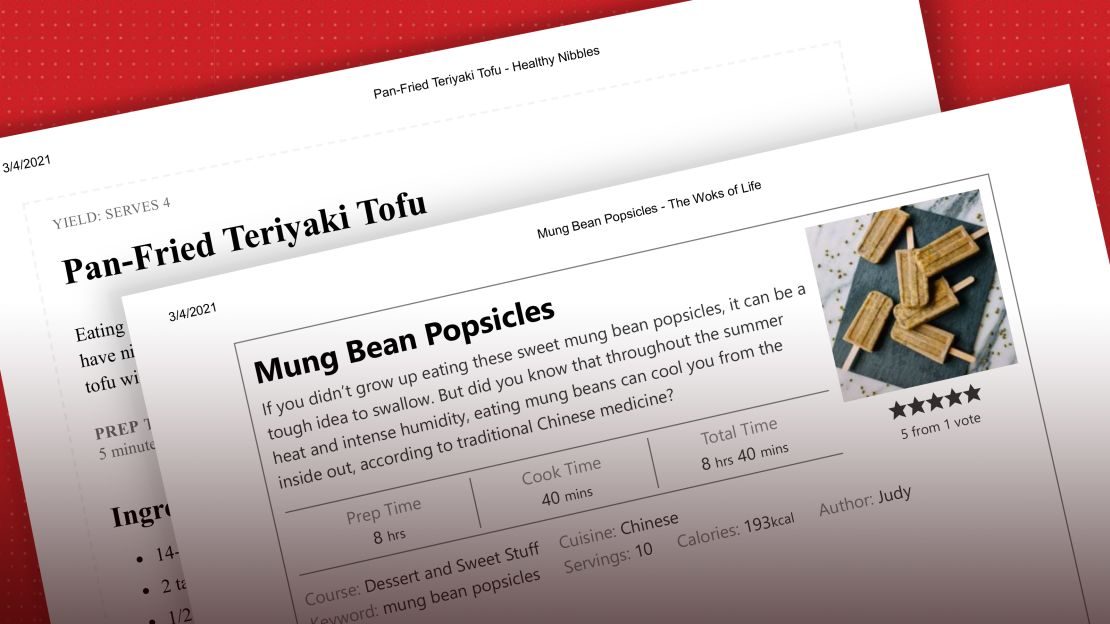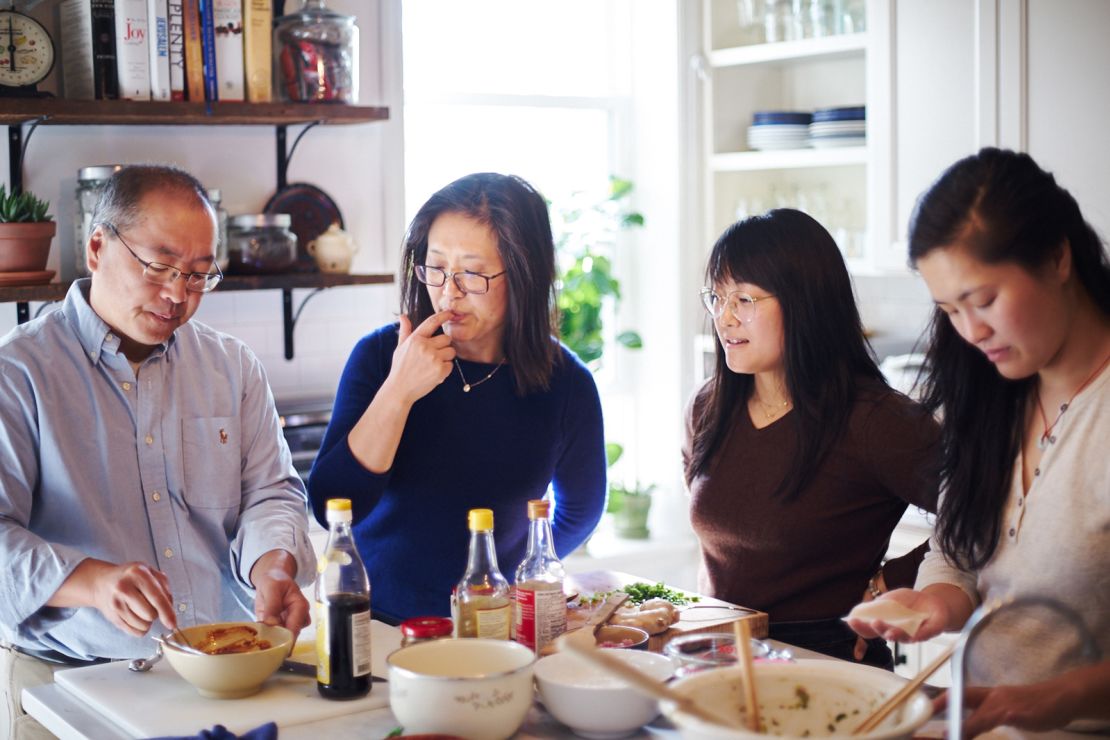Not everyone wants to cook mung bean popsicles. Judy Leung, one of the people behind recipe website The Woks of Life, understands that.
So when she shared her recipe online, she opened her blog post by taking the reader back to Shanghai, where she grew up. There, she wrote, popsicle peddlers would ride through the city on bicycles, wooden boxes strapped to the backseats, selling the treat.
“When the neighborhood kids heard the peddlers’ distinguished hollers, they would charge out with pennies in hand, hoping to get the popsicle with the most beans,” the post, which also features illustrated step-by-step cooking instructions, reads. “Everyone knew they were the best part.”
For Leung – and many other cooks who make a living as food bloggers – telling the story behind certain dishes is part of the recipe itself. But over the weekend, a proposed website – called Recipeasly – raised concerns among the community of food bloggers. It said it would provide recipes sans information beyond an ingredient list and cooking steps.

Tom Redman, one of the website’s creators, described it as “your favorite recipes except without the ads or life stories.” Users would be able to plug in their recipe of choice, and the site would strip it of any extra text – including the recipe author’s name.
The news of the website was immediately met with backlash.
Redman apologized soon after and said he was taking down the website down as its creators “re-examine our impact on the community.” He did not immediately respond to CNN’s request for comment, but tweeted that if the site returns it’ll be “with changes where we have fallen short.”
While the website is now down, news of its launch amplified a larger issue, many food bloggers said. So often, people simply want a recipe, without the person behind it. And stripping food bloggers’ of their stories, they said, devalues their work – and their humanity.
“It pulls our identity away from the thing we’re creating, which personally, is hurtful,” Mila Clarke Buckley, who runs the diabetes-focused recipe website Hangry Woman, told CNN. “I’m making this thing for you, but you don’t want me to be a part of it. You want me to be these invisible hands in the background.”
Those long posts are actually useful
Every food blogger has heard some version of the same complaint: Cut to the chase. Many don’t want to read a long post before the recipe – they just want the recipe.
But that complaint is one based in an overgeneralization of recipe websites, said Lisa Lin, who has run the website Healthy Nibbles and Bits since 2014. It’s based on a reality that was more prominent in the early days of food blogging, she said.
“Back then, it was more of a blog first, and recipe second,” Lin said. “People were there to follow the person, as opposed to the food … But in recent years, it’s shifted to more becoming a food website.”

Now, Lin said most recipe posts focus on how to cook that recipe, or why the author is using certain ingredients. It’s all in an effort to arm the user with as much information as possible.
And it’s not like every recipe Lin posts gets this treatment, or requires it. In a recipe for crispy teriyaki tofu, for example, Lin mainly gives instructions on how to press the tofu so it comes out as crispy as possible, before jumping to the ingredient list and the instructions. The information she does include, though, is still relevant.
Clarke Buckley, who has written Hangry Woman since 2016, always includes context at the top for what ingredients to use. Writing for people with diabetes, she wants them to understand the deeper contexts as for whatever swaps she makes, because it’s a benefit for their health, she said.
“Someone without diabetes … might not need that context, but there are resources to get to the recipe as fast as possible if they want that,” she said.
And it’s true. Most recipe websites have a “jump to recipe” button somewhere near the top, so users can skip ahead, if they so choose. There’s no shame in that.
Clarke Buckley said she once tried to write a shorter recipe post, with little instruction at the top before cutting to the recipe. She ended up with loads of questions about where the recipe came from, what tools to use, and other things she would’ve addressed in a longer post.
“(It) might be more intensive for the user because they have to scroll, but it actually helps us give people all the information they need,” she said.
In his tweets, Redman said the the goal of Recipeasly was not to “minimize” the results of food bloggers hard work. But, he added, “Clearly, how we’re marketing Recipeasly doesn’t demonstrate that respect at all. We missed the mark big time and I’m sorry.”
Stripping them devalues a food bloggers’ work
Because most food blogs are run by women, some experts say a website like Recipeasly could signal a devaluing of women’s work – as these recipe websites are already providing the content for free.
“The food blogosphere definitely skews towards female authorship and readership, which is also probably why so many people trivialize the characteristics that define a food blog, such as the stories,” Dr. Tisha Dejmanee, a lecturer of digital and social media at the University of Technology Sydney, told CNN.
Dejmanee, who has done research on the intersections of feminism and food blogs, said recipe developers typically put hours of work into testing recipes, food styling and photography to create high quality content.
Recipeasly, and any apps or websites like it, can hurt revenue streams for these creators.
Rather than crediting them for their work, tools like Recipeasly would actually erase the labor of the developers by “commoditizing their recipes to generate a personally profitable business model, which is clearly an exploitative relationship,” Dejmanee said.
The primary way most food bloggers get paid, Clarke Buckley said, is through ads and sponsorships. Recipeasly seemingly wanted a recipe developer’s time and labor, but they didn’t want to pay for it and they don’t want the developers to get paid either, Clarke Buckley said.

In his series of tweets, Redman clarified the website creators “do not make any money off of this. There is *no* revenue, much less profit,” he wrote.
It feeds into the commodification of food
Part of the demand for getting recipes instantly, Lin hypothesized, has to do with the commodification of food.
“When we buy iPhones, we don’t think about the context,” Lin said. “That’s how some people view food, it’s just a mere commodity, to just feed hunger, but they don’t also think about the person who’s making it.”
That lack of thought for the person making the food isn’t new. There’s a long history of making food work invisible, Dejmanee said, such as the gendered stereotype of hiding the suburban cooking woman in a closed-off kitchen, as she effortlessly provides a home-cooked meal every night for her family.
“As this nostalgia has been translated into the digital era, the business model of blogging often requires bloggers to systematically devalue their own work by pretending that these are just home-cooked, everyday meals, because this is part of the fantasy and appeal of food blogging,” Dejmanee said.
It ignores that recipes aren’t just food; they’re culture
For Sarah and Kaitlin Leung, who created The Woks of Life with their parents Judy and Bill in 2013, the website isn’t just about providing recipes. First and foremost, it’s a culinary genealogy.
Though they do have a “jump to recipe” button at the top of their pages, they told CNN they actually do see most people wanting to read about the dishes they post.
“I think that desire to disregard context and put empathy aside in the interest of whatever personal drive you have – to just get dinner on the table – I think it’s a lost opportunity to have a more meaningful engagement,” Kaitlin Leung said.

The Leung sisters used their mom’s mung bean popsicle recipe as an example.
Though people love to make fun of grandma stories, Kaitlin said, as her mom tests recipes, memories flood back from her childhood, things she may have even forgotten herself. Part of writing that story is for that documentation, for her, for the kids, or for future generations, Sarah Leung said.
And for the audience, some of whom may not have heard of mung bean popsicles before, it just adds much more context around the dish.
“For people to see that this was once the coveted thing for a little girl in China … it tells why this is a valued recipe, and tells why we’re taking the time to share it,” Kaitlin Leung said. “It’s a firsthand perspective of history. It might seem small to people because it’s just food, but it’s important.”
And those stories, those histories, are sometimes just as important as something like how much salt to use.
“It’s a sign of respect to the culture, that you’re bothering to explain why things are done a certain way. And if you don’t, you’re not really giving the due respect to the people who developed the dish, the lineage,” Lin said.
“If you see a recipe for a dish that doesn’t have that context, it sort of devalues the thing that you’ve cherished for so long.”
Lin used the context of Chinese New Year as an example, saying that new year’s dishes are very “near and dear.” The holiday is similar to Christmas in the US, she said. With dishes like that, the context is important, because the dishes hold so much weight.
“To some people it’s just food,” she said. “But it’s also a symbol of our culture and our history.”
So much of the debate around Recipeasly, and efforts like it, seem to stem from a lack of consideration for the people behind the blog.
And with lack of thought, comes lack of appreciation – for the food, for the cook and ultimately for the culture.


